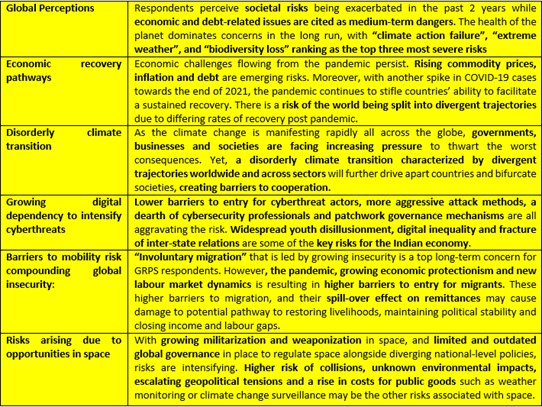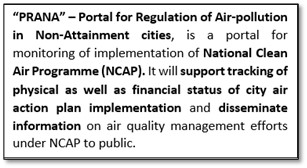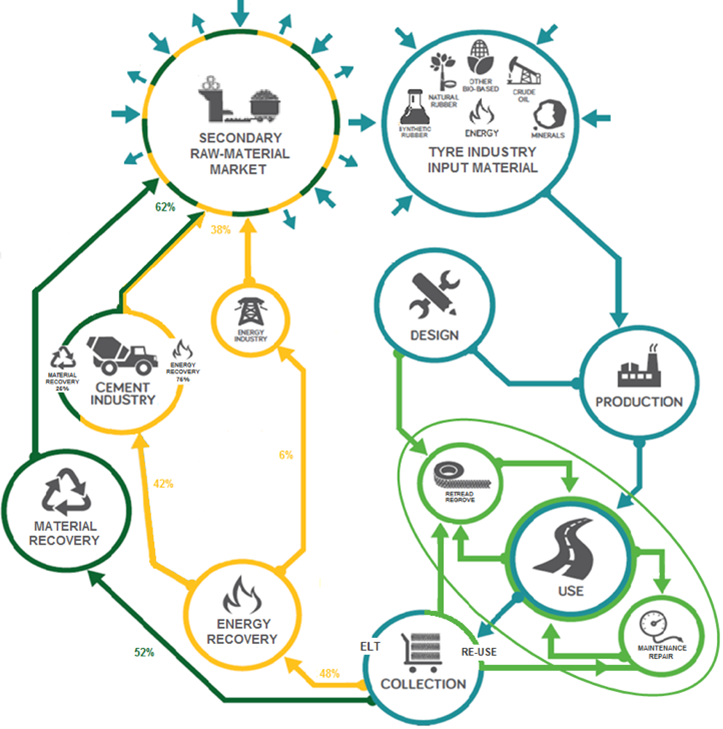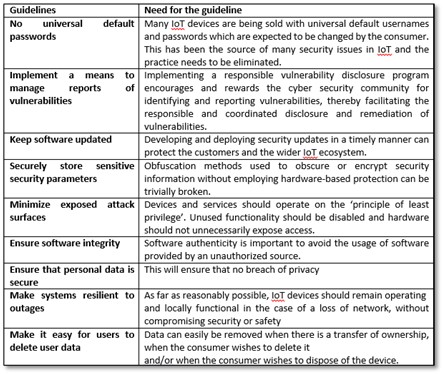Thursday, 13th January 2022
State-wise Minority Determination
In News
The Supreme Court has asked the Centre to respond to a petition for classifying religious minorities based on their population in each state and transferred to itself similar petitions pending before three high courts.
About the News
- The PIL has sought a state-wise determination of minority status on the basis of population for the purpose of administering educational institutions instead of nation as a metric to identify minority communities.
- The PIL specifically challenged the validity of Section 2(f) of the National Commission for Minority Education Institution Act, 2004, on the ground that it gave unbridled power to the Centre to declare any group as a minority without there being proper guidelines.
- Section 2(f) of NCMEI Act empowers the Centre to identify and notify minority communities in India.
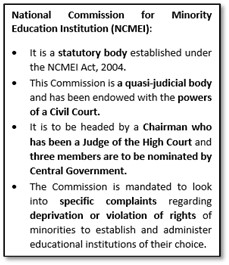
Who are Minorities?
- United Nations has defined minorities as “Any group or community which is socially, political and economically non-dominant and inferior in population are minorities”.
- The constitution mentions the term ‘minority’ covering both linguistic and religious minorities in Article 29 and in Article 30 but it does not define the term.
- The Central government determined five religious minorities in India under the National Commission for Minorities Act, 1992. These religious minorities include Muslims, Sikhs, Buddhist, Parsis and Christians. Linguistic minorities are determined by the respective state governments.
- Few of the religious minorities are a majority in some states, while Hindus are a minority in 8 states in India as per 2011 census. But, as the determination of minority status is at the national level, they cannot avail the benefits accorded therein.
Important SC rulings on the matter
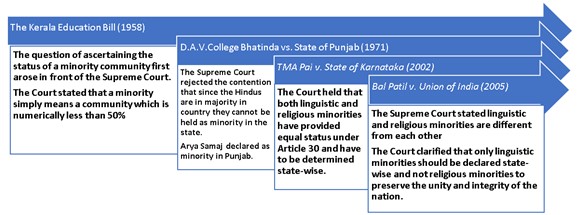
Way Forward
- In Bal Patil vs Union of India, SC said that “The constitutional goal is to develop citizenship in which everyone enjoys full fundamental freedoms of religion, faith and worship and no one is apprehensive of encroachment of his rights by others in minority or majority.”
- The status of religious and linguistic minorities still remains highly ambiguous and further clarity is required in order to create a clear distinction between the two.
- A clear procedure should be introduced to determine the status of minorities both at state as well as national level to streamline the identification process. A robust and fair identification process would allow such communities to avail their legitimate share in the state resources.
Sources:
PM-KUSUM Scheme
In News
Public sector banks have agreed to grant collateral- free loans to farmers in Rajasthan for installing solar plants at their infertile or semi-barren land, under the PM-KUSUM (Pradhan Mantri Kisan Urja Suraksha evam Utthaan Mahabhiyan) scheme.
About the News
- Rajasthan was the first State to have completed the selection of farmers for installation of solar plants on their land in 2021 with the capacity exceeding Centre’s targets.
- The Rajasthan Renewable Energy Corporation had allotted 722 MW plants to 623 farmers under the KUSUM scheme (launched in 2019).
- The farmers who do not have money to invest can lease out their land to private developers and receive an annual income. The availability of power near the sub-stations will also help reduce transmission losses as well as expenses for expansion of infrastructure of discoms.
Understanding KUSUM Scheme
- Ministry of New and Renewable Energy (MNRE) has launched the Pradhan Mantri Kisan Urja Suraksha evem Utthan Mahabhiyan (PM KUSUM) Scheme in the year 2019 for farmers to install solar pumps and grid connected solar and other renewable power plants.
- The Scheme envisages income generation for farmers from their infertile land with the establishment of solar power plants.
- While the farmers can sell the power generated from the solar plants to the power distribution companies, the solar pumps can also be installed for irrigation of agricultural land.
- Scheme is aimed at ensuring energy security for farmers in India, along with honouring India’s commitment to increase the share of installed capacity of electric power from non-fossil-fuel sources to 40% by 2030 as part of Intended Nationally Determined Contributions (INDCs).
- The Scheme was launched with 3 components:
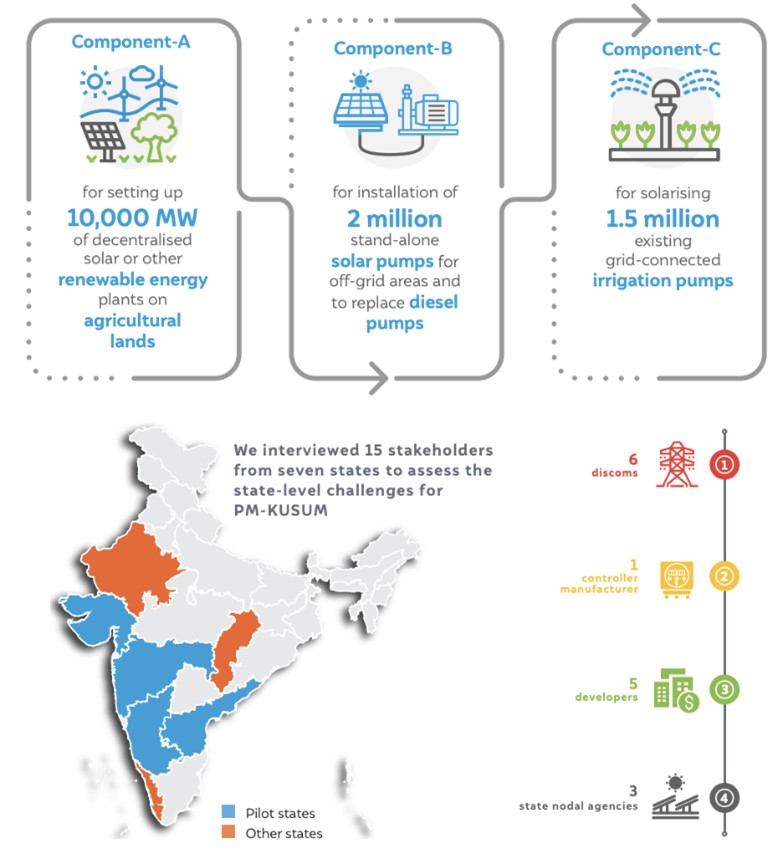
Component-A:
- For Setting up of 10,000 MW of Decentralized Grid Connected Renewable Energy Power Plants on barren land.
- Under this component, renewable energy-based power plants (REPP) of capacity 500 kW to 2 MW will be setup by individual or group of farmers/ cooperatives/ panchayats/ Farmer Producer Organisations (FPO) etc on barren/fallow land.
- The power plants can also be installed on cultivable land on stilts where crops can also be grown below the solar panels.
- The renewable energy power project will be installed within 5 km radius of the sub-stations to avoid high cost of sub-transmission lines and to reduce transmission losses.
- The power generated will be purchased by local DISCOM at pre-fixed tariff.
Component-B:
- Under this Component, individual farmers will be supported to install standalone solar Agriculture pumps of capacity up to 7.5 HP for replacement of existing diesel Agriculture pumps / irrigation systems in off-grid areas, where grid supply is not available.
Component-C:
- Under this Component, individual farmers having grid connected agriculture pump will be supported to solarise pumps.
- The farmer will be able to use the generated solar power to meet the irrigation needs and the excess solar power will be sold to DISCOMs at pre-fixed tariff.
Source:
Image Source:
Delhi’s Plan to Reuse water
In News
The recently released Delhi Master Plan aims to cut city’s potable water demand to 50 gallons per capita by 2041.
About the News
- Ministry of Housing and Urban Affairs has made public the draft Regional Plan 2041 for the NCR with suggestions to deal with the supply, use, and reuse of water, and the management and use of water bodies in NCR.
- It also aims to reduce demand of potable water for domestic use rationally and progressively to 50 gallons per capita daily from the present 60 GPCD.
What are the important features?
- Recycling of waste water: Water demand for industrial and horticulture/gardening/agriculture purposes is to be fulfilled from recycled waste water of desired quality standards.
- Water management: Several management strategies to reduce the demand for fresh water in the city, including “treating waste water for non-potable uses”, “water supply rationalisation” and “low water consumption plumbing fixtures”.
- Reducing Water stress: Water supply in new developments under the various policies to be controlled to minimise additional stress on water resources.
- Integrated urban water management approach: An integrated and inter-connected strategies in major water-related infrastructure sectors, namely water supply, sewerage and drainage.
- Optimising bulk-use: In order to optimise bulk reuse of waste water, the plan suggests agencies to ensure that only treated waste water shall be permitted to be discharged into drains or water bodies.
What are the major Challenges?
- Depletion of ground water resources potentially causing further dependence on water resources from outside the region.
- Ever-rising water demand due to increasing population in the NCR region.
- Uneven water coverage among sub-regions below prescribed standards both in urban and rural areas.
- Dwindling local sources of water supply such as ground water due to pollution, water quality is deteriorating.
- Reliance on external water sources to meet major part of water demand exposes the sub-regions to uncertainties of supplies from areas outside their jurisdiction.
- Lack of adequate number of water treatment plants in NCR creating more pressure on use of freshwater sources and also have polluted freshwater sources.
- Little reuse of wastewater and insufficient infrastructure for the treatment of wastewater hinders augmentation of water supplies through reuse. It also causes pollution of freshwater sources.
- Dumping of solid wastes in storm water drains, natural drains and water bodies reduces their capacity to absorb or convey the storm water effectively.
- Increase in short period rain intensity and frequency due to Climate change affecting urban drainage.
Strategies suggested in the Plan to address these challenges
- Agricultural Water Demand: Water consumption levels in agriculture sector should be managed through the right choice of crops, in accordance with water availability and priorities.
- Extraction of Ground Water: Registration & Geo-Tagging of all bore wells/ tube wells/ other wells and sensor monitoring of ground water status should be carried out across NCR.
- Ground Water Recharging: Recharging of aquifer should be taken up immediately by constructing suitable rain water harvesting structures such as recharge pits, recharge trench, recharging dug wells, recharge shaft.
- Revival and rejuvenation of rivers/water bodies by 2026: Revival and rejuvenation of river Yamuna should be taken up as a priority with viable financial strategy may be worked collaboratively for its implementation.
- Water Sensitive Planning: Clear identification of natural drainage systems and watersheds should be done on the principles of water sensitive planning.
- Reuse of wastewater: Necessary augmentation of water treatment plants and other water infrastructure should be carried out by the NCR States.
- Augmentation of Water: New sources of water for the NCR population should be also explored. This should be done by promoting inter-basin transfers as one of the sources of water.
- Water use efficiency in Agriculture- Irrigation: Water and electricity for agriculture should not be provided free of charge in the NCR.
- Drainage and Storm Water Management: Prepare & implement Storm water Drainage Plans for all towns.
- Water Management and Administration Systems: To be a water + region, “water balance table” for each sub region, district and towns of the NCR should be prepared, as part of each sub-regional Plans.
Sources:
Rakesh Sharma
On January 13, 1949, Indian Indian military pilot and cosmonaut, the first Indian citizen in space, Rakesh Sharma was born. In 1970 Sharma joined the Indian Air Force as a pilot. He flew 21 combat missions in a MiG-21 in the Bangladesh war of 1971. In 1982 he was selected as a cosmonaut for a joint Soviet-Indian spaceflight. On April 3, 1984, he flew on board Soyuz T-11 with two Soviet cosmonauts. Astronaut Rakesh Sharma spent seven days, 21 hours and 40 minutes in space as part of a joint programme between the Indian Space Research Organization (ISRO) and the Soviet Interkosmos space programme. His work in space was focused on areas of biomedicine and remote sensing. In order to cope with space sickness, Sharma took to 'zero gravity yoga'. Apart from being the first Indian to stay in space, Rakesh Sharma is also the first Indian to have been conferred with the 'Hero of Soviet Union' award. He was also awarded Ashok Chakra alongwith his Russian co astronauts Yuri Malyshev and Genadi Strekalov.
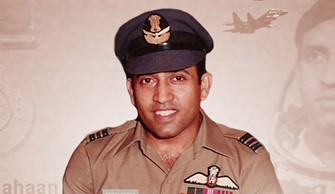
Source:
CAG Report on Ground Water Management and Regulation
In News
The Comptroller and Auditor General of India (CAG) conducted the performance audit of groundwater management and regulation in the country.
Introduction and background
- Ground water (GW) is the water which exists below the surface in the zone of saturation (aquifers) and can be extracted through wells or any other means or emerges as springs and base flows in streams and rivers.
- Aquifers are geologic formations (i.e. sands and gravels) which permit appreciable quantity of water to move through them.
- Ground water is an annually replenishable resource but its availability is non-uniform in space and time.
- As per Dynamic Ground Water Resources of India published by Central Ground Water Board (CGWB),
- India’s annual replenishable GW resource is assessed as 432 billion cubic meter (bcm).
- Keeping 39 bcm for natural discharge, the net annual GW availability is 393 bcm.




Key Audit findings
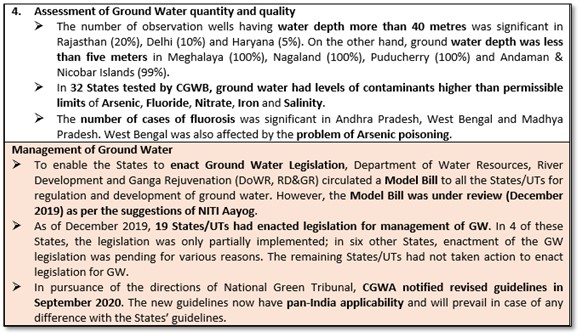
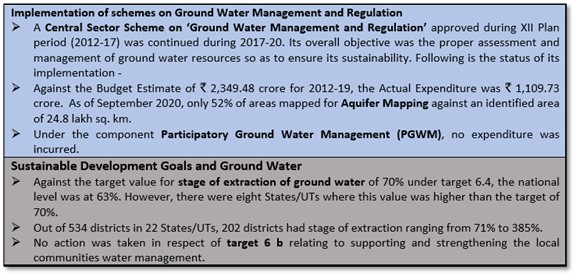
Recommendations of the CAG
- The government may take expeditious action to revise the Model Bill and also pursue with the remaining States for bringing comprehensive laws/regulations to deal with ground water management.
- Central Ground Water Authority and State agencies need to develop effective coordination with various other agencies granting consents to projects to ensure that the requisite permissions to extract ground water are also obtained.
- Central Ground Water Authority and State agencies need to establish a system for periodic inspections and review of the projects to ensure compliance to the conditions mentioned in the No Objection Certificates.
- The government may develop a strategy for expeditious completion of aquifer mapping and modelling of the identified area within a reasonable time period.
- Participatory Ground Water Management, being one of the key activities for sustainable ground water management, may be executed in a time-bound manner through Atal Bhujal Yojana and this scheme may be considered for scaling up to the entire country, thus involving all the States.
- The government may review the mandate of CGWB and take steps to strengthen the organisation to achieve the commitments made by the country in the 2030 agenda for Sustainable Development Goals.
- The government may impress upon the State Governments to review the performance of their ground water schemes and take measures to ensure that the envisaged results are achieved by adopting an integrated approach for recharge/augmentation of ground water.
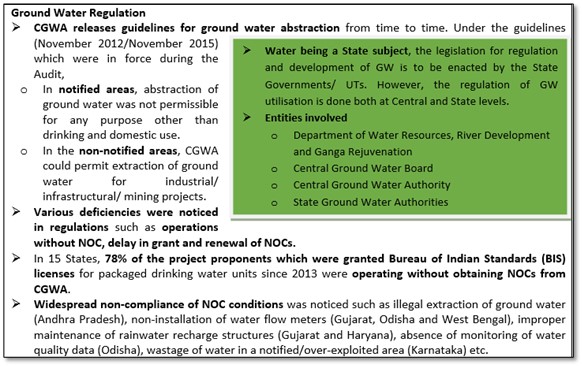
Question: The groundwater management and regulation in India needs to be relooked into. Elaborate on the basis of latest CAG report on groundwater management.
Sources:
Water on Moon
This is image of the surface of Earth’s moon on which China’s Chang’e 5 lunar lander has found the first-ever on-site evidence of water. A study published a journal Science Advances revealed that the lunar soil at the landing site contains less than 120 parts-per-million (ppm) water or 120 grams water per ton, and a light, vesicular rock carries 180 ppm, which are much drier than that on Earth. he rock is estimated to hail from an older, more humid basaltic unit. The presence of water had been confirmed by remote observation but the lander has now detected signs of water in rocks and soil. A device on-board the lunar lander measured the spectral reflectance of the regolith and the rock and detected water on the spot for the first time. It was the solar wind that contributed to the most humidity of lunar soil as it brought hydrogen that makes up the water. The investigations of lunar water reserves come into the limelight as the building of manned lunar stations are in the pipeline in the next decades.
Source:
Easing curbs on Chinese investments
- Context: India is considering to ease the scrutiny on FDI from neighboring countries.
- This move aims to clear the bottlenecks to inflow of FDIs, which were created due to restriction aimed at China.
- Currently, the government scrutinizes all investment proposals from companies that are either based in countries that share a land border with India or have an investor from one of these nations.
- The new mechanism aims to exempt the proposals where the so-called beneficial ownership is less than 10%, which means the investor may be from a neighboring country but holds only a small stake in the firm proposing the investment.
- The move is being considered after proposals worth $6 billion were stuck amid the red tape. Red tape is a derisive term for excessive regulation or rigid conformity to formal rules that is considered redundant or bureaucratic and hinders or prevents action or decision-making. It is usually applied to government, but can also be applied to other organisations like corporations.
- Relaxing the rules will broaden the pool of investors that capital-hungry Indian firms can tap, as local firms increasingly turn to large global investors to fund their growth.
- India over the last two decades has received a cumulative of $457 billion in FDI. Among these, 72% contributions is from five countries like Mauritius, Singapore, USA, Japan and Netherlands.
- Between the years 2016-19, there have been 12x times growth of Chinese investment, especially in start-ups.
- Following political tensions between India and China in 2020, India sought to limit Chinese investment in sensitive sectors and subjected imports of Chinese goods to extra scrutiny.
Source:
Image Source:
Adi Shankaracharya - Edukemy Current Affairs
- Context: Madhya Pradesh government is planning to construct a 108 feet high statue of Adi Shankaracharya on the bank of Narmada river at Omkareshwar in Khandwa district.
- Adi Shankara also called Shankaracharya is said to have been born in Kaladi village on the bank of the Periyar, the largest river in Kerala.
- He was a renowned exponent of the Advaita Vedanta School of philosophy, from whose doctrines the main currents of modern Indian thought are derived.
- Advaita Vedanta articulates a philosophical position of radical nondualism which it derives from the ancient Upanishadic texts.
- The fundamental thrust of Advaita Vedanta is that the atman is pure non-intentional consciousness. It is one without a second, nondual, infinite existence, and numerically identical with brahman.
- Being a follower of Shaivism, his thought process was quite away from Buddhism and his life-time contributions were focused on revival of Hinduism.
- He left home very early in search of learning and to become a
- Padmapada, Sureshvara, Totaka (or Trotaka), and Hastamalaka were his pupils.
- His contributions include
- Commentaries on the Brahma-sutra (Brahmasutrabhashya)
- Upanishads
- Bhagavadgita and
- Bhajagovinda stotram

Sources:
Improved Passport Power: India
- Context: As per the Henley Passport Index, India’s passport power has improved this quarter compared to 2021.
- Henley Passport Index ranks world’s passports since 2005, according to the number of destinations their holders can access without prior visa and is based on data from International Air Transport Association (IATA).
- India now ranks at 83rd position in the Index, climbing seven places from 90th rank last year sharing the position with Sao Tome and Principe in Central Africa, behind Rwanda and Uganda.
- Japan and Singapore have topped the index.
- However, in 2020, India’s rank stood at 84 while in 2016, we were ranked 85th along with Mali and Uzbekistan.
- India currently has visa-free access to 60 destinations worldwide with Oman and Armenia being the latest additions.
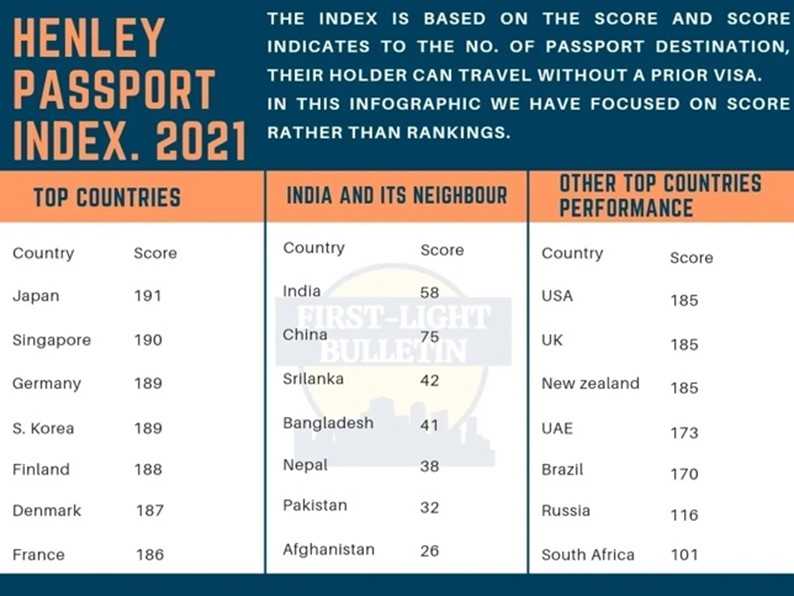
Source:
Image Source:
Red Sanders - Edukemy Current Affairs
- Context: Red Sanders has fallen back into the ‘endangered’ category from its earlier category of ‘near threatened’ in the IUCN Red List.
- Red Sanders or Red Sandalwood (Pterocarpus santalinus) is an Indian endemic tree species, with a restricted geographical range in the Eastern Ghats.
- The species is endemic to a distinct tract of forests in Andhra Pradesh that covers the districts of Chittoor, Kadapa, Nandhayal, Nellore and Prakasam.
- It is known for its rich hue and therapeutic properties throughout the Asia particularly in China and Japan, where it finds application in cosmetics, medicinal products, for making furniture, woodcraft and musical instruments.
- However, there has been a significant decline of about 50-80% of its population in its natural habitat due to over-exploitation especially for smuggling related activities, forest fires, cattle grazing etc.
- The Species is scheduled in appendix II of CITIES and Schedule II of Wildlife Protection Act.

Source:
Image Source:
The touchstones of effective regulation: HBL
Essence: In current times when regulation is seen as a panacea for any kind of issues being faced by the market, danger of excessive or mis-timed regulation hurting interest of market becomes real. A proactive regulation is necessary to address market failure and at times also to achieve non-market goals like ensuring equity by providing for reservation in public issues for retail individual investors.
However, the author underlines the importance of adequate due diligence before introducing any regulation. Objective cost benefit analysis of different available options must be done before opting for regulation, lest cure becomes a disease.
Why should you read this article?
- To understand the importance of regulator for a market and society.
- To appreciate the need of due diligence before opting for regulation to fix any problem.
- To understand different factors responsible for market failure
Source:
Establishing India’s Apple: TH
Essence: The $3 trillion market value of Apple, a U.S. tech company, raises the question of whether India can or will be able to develop a company like Apple. For this, India must understand how a research-and-development-driven economy works, as well as the universities' critical role in it. To develop ideas into workable solutions, government support is essential at first, but once established, private enterprises can be backed by private investors. Tech transfer offices and incubators play a critical role in the commercialization of technologies in this area. While STEM (Science, Technology, Engineering, and Mathematics) disciplines will drive innovation away from university campuses, it is critical to widen the scope to include all liberal arts streams. Universities may play a vital part in developing the economies of all nations, with the market capitalizations of many technology-driven enterprises placing in the top 20 of global GDP alongside nation-states. The time has arrived for Indian institutions to give value beyond their conventional roles of knowledge creation and teaching.
Why should you read this article?
- To comprehend the criteria for the development of a corporation such as Apple.
- To comprehend how universities can play an important role.
Source:
Reaping India’s demographic dividend: TH
Essence: India is somewhere in a middle of demographic transition. National investment in children and youth have high potential of long-term returns. Low fertility rate, increase in the share of working age population and smaller share of children in population opens up window for harnessing the demographic dividend. But there are social and economic challenges. They can be solved through policy measures.
The article talks about solutions like National Transfer Account (NTA) Assessment, investing more in children and adolescent, investing in health and education, increasing female workforce participation in economy, addressing diversity between states and governance reforms with a new federal approach. The article underlines that India has unique opportunity to realize the benefits of potential demographic dividend.
Why do you need to read this article?
- To understand that India has a unique opportunity to realize the benefits of potential demographic dividend.
- To realize the importance of this solution-oriented article as it suggests various policy measures that India can take up to develop and get richer before ageing sets in.
- This article becomes relevant for population related issues (GS I), Government Policies (GS II) and Essay.
Source:
Smart and Sustainable transport
Background
- Inland water transport was once a primary means of freight and passenger transport on Vembanadu Lake, Kochi.
- Newly launched Kochi Water Metro aims to make inland water transport inclusive and environmentally sustainable.
How will Kochi Water Metro help sustainability?
- Improves Connectivity: The Water Metro is a smart plan, which envisages an integrated water transport system with the development of 15 identified routes, connecting 10 islands along a network of routes.
- Officials claim that it is the first time in the world a centrally controlled integrated water transport system with a large fleet is powered by battery.
- Socially Inclusive: More than one lakh islanders will benefit from the water metro, which is designed to be a socially inclusive transport system, with focus on improved livelihoods through commercial property development and tourism-based initiatives.
- Efficient Ridership: The project intends to introduce modern, energy efficient, environment friendly and safe boats with low wake and draft characteristics at a high frequency to increase ridership.
- Reduce Pollution: It is expected to reduce pollution and traffic congestions in the city and ease access to business areas on the mainland for urban households situated along the Kochi lakeshore.
- Thus, the Kochi Water Metro sets an example for sustainable, efficient and economic transport.

Quote: “The test of democracy is not the magnificence of the buildings or the speed of automobiles or the efficiency of air transportation, but rather the care given to the welfare of all the people.”
- Hellen Keller
Source:
Image Source:
Share the article
Get Latest Updates on Offers, Event dates, and free Mentorship sessions.

Get in touch with our Expert Academic Counsellors 👋
FAQs
UPSC Daily Current Affairs focuses on learning current events on a daily basis. An aspirant needs to study regular and updated information about current events, news, and relevant topics that are important for UPSC aspirants. It covers national and international affairs, government policies, socio-economic issues, science and technology advancements, and more.
UPSC Daily Current Affairs provides aspirants with a concise and comprehensive overview of the latest happenings and developments across various fields. It helps aspirants stay updated with current affairs and provides them with valuable insights and analysis, which are essential for answering questions in the UPSC examinations. It enhances their knowledge, analytical skills, and ability to connect current affairs with the UPSC syllabus.
UPSC Daily Current Affairs covers a wide range of topics, including politics, economics, science and technology, environment, social issues, governance, international relations, and more. It offers news summaries, in-depth analyses, editorials, opinion pieces, and relevant study materials. It also provides practice questions and quizzes to help aspirants test their understanding of current affairs.
Edukemy's UPSC Daily Current Affairs can be accessed through:
- UPSC Daily Current Affairs can be accessed through Current Affairs tab at the top of the Main Page of Edukemy.
- Edukemy Mobile app: The Daily Current Affairs can also be access through Edukemy Mobile App.
- Social media: Follow Edukemy’s official social media accounts or pages that provide UPSC Daily Current Affairs updates, including Facebook, Twitter, or Telegram channels.

